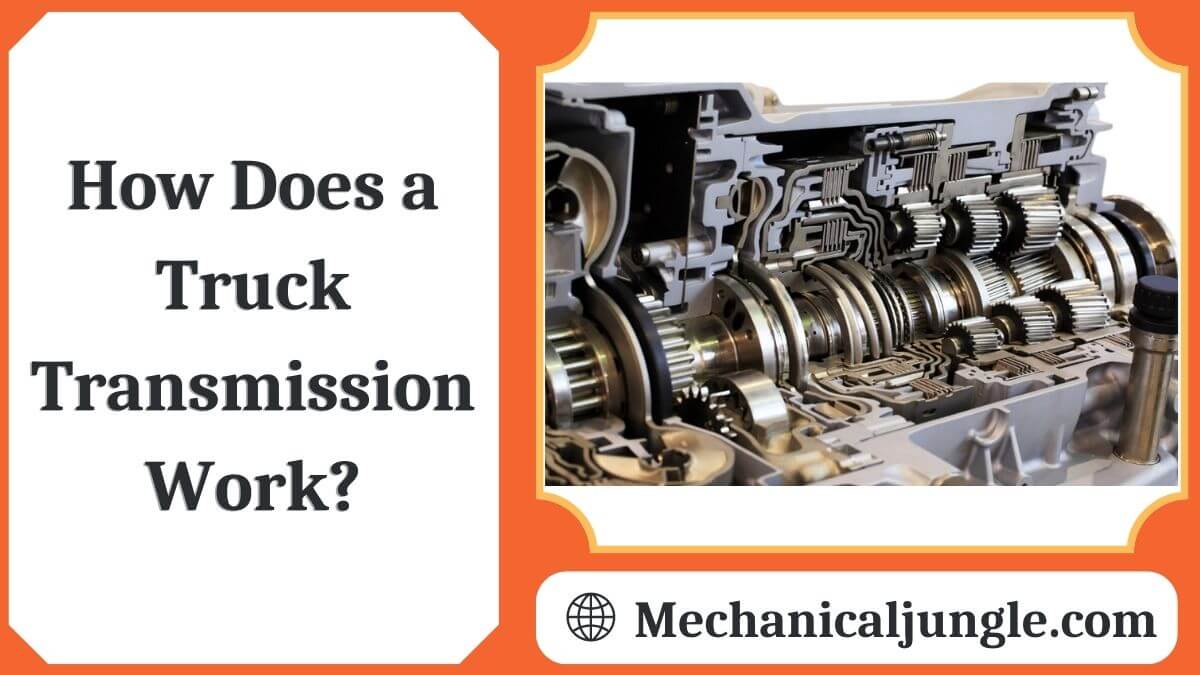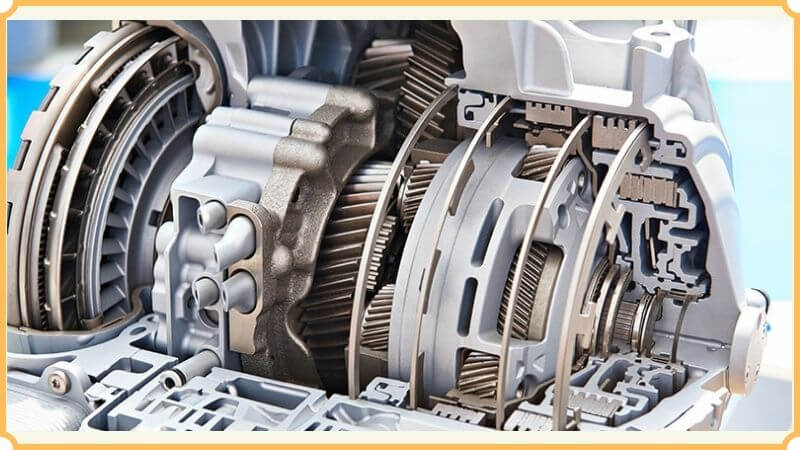
What Is a Truck Transmission?
Most people think that the engine is the heart of the vehicle, but it only converts the fuel into mechanical energy. Without transmission, the vehicle engine is unworkable.
Turck transmission is an engine that takes the rotation force and navigates through the mechanism of difficult gear. It turns the drive wheel to get the tonnes of load to move or transport from one place to another.
How Does a Truck Transmission Work?
The essential part of any transmission is its gearbox and clutch. These parts in the vehicle act as an interlocutor and gateway in the middle of the engine and the vehicle’s rest. Changing the gear ratio of the vehicle changes, or the gearbox changes the output of the internal combustion engine.
Switching between the small and large gears will stop the engine from overworking and help to keep the vehicle working and running at the optimum efficiency. The gearbox gets engaged and disengaged by the clutch; its meaning is that it gets changed, or the gear gets changed without any damage.
In a class rear-wheel drive vehicle, the energy or the power is transferred. Down to a rotating drive shaft before it meets the differential, which will redirect the energy/power to turn axles on which wheels are mounted.
Every type of vehicle, like hatchbacks, SUVs, and heavy carriers, has a dive train, which is slightly dissimilar. From 1959 the mini pioneered the front-wheel-drive transaxle, mounting the engine transversely, which is small, sideways in line with the front-wheel drive.
Many of the vehicles have adopted the same front-wheel drive. But many trucks and tractors are still used or have rear-wheel drive. Many rigid trucks have either a 4×2 axle or a 6×2 layout.
In these, the first number is referred to as the number of wheels, and the second one is referred to as the number which receives power. Most tractors that are large have a layout of a 6×4 axle. Its meaning is that both rear axles are driven by the train.
Specialists advised that to maintain the vehicle’s roadworthiness, guidelines indicate that the transmission inspection is necessary every six weeks. But the transmission needs inspection regularly and sometimes not regularly.
It depends on the vehicle’s condition. But a complete vehicle service is needed, or it is necessary only once in the year.
How Do Semi Truck Transmissions Work?

Trucks have two types; the first is used for recreational uses. Truck transmission is similar to a car’s transmission, but the truck has geared up to 6 gears, or it can either be automatic or manual.
In heavy and large trucks, there are three types of transmission: range, splitter, and range-splitter. Firstly we will discuss the range transmission.
This range transmission is similar to that used for small trucks. But it has low-high split gear, allowing it to reuse the same gear shift position for the gear in low and high mode. The transmission of the splitter also used the high-low division.
Instead of using a high section and a low section, these gears will be split into two so that each position of the gear shift is used for the two gears.
One is on a high, and one is on a low. And the third transmission is the range splitter, and this range splitter transmission is a combination of two setups that allow for the position of greater gear and selections.
Where Is the Transmission in the Vehicle Located?
The transmission is an essential part of any vehicle and will ensure that the right of the energy or power is sent towards the wheel to keep the speed you want.
If the vehicle you use is a front-wheel drive, then the transmission in such a vehicle is placed under the front hood as the drivetrain component.
The transmission is a bit lower than the vehicle’s engine. And if the vehicle you are using is a rear-wheel drive vehicle, then transmission.
Is located behind the vehicle engine or under the area of the dashboard. It is joint/connected with a drive shaft that will pass from the transmission toward the vehicle’s rear.
Many People Are Wondering What Transaxle Is?
In many modern front-wheel drive vehicles, the vehicle transmission and the differential are combined into one unit known as the transaxle. With the engine, these gizmos connect directly to form or generate the drivetrain. This whole big honking ‘compilation is placed under the front hood.
What Do You Mean by Semi-Automatic Transmission?
Semi-automatic transmission is nothing but a multiple-speed transmission where components of its operation are automated. But it still required the driver’s input to launch the vehicle from rest and manually change the gear.
Generally, the semi-automatic transmission, which is used mainly in cars, trucks, and motorcycles, is built on the conventional sequential manual transmission or manual transmission, but it uses the system of the automatic clutch.
Semi-automatic transmission is built on the automatic hydraulic transmission with the torque converter and planetary gear sets. Transmission is the system that ultimately powers your semi-truck. Using the truck’s gearbox, either you can slow down or speed up the truck.
Some people prefer to drive the manual semi-truck because they enjoy the ride and the full control of the vehicle they get by driving the manual transmission.
On the other hand, some people prefer to drive with the ease of an automatic semi-truck. There are also two types of transmission in semi-trucks. One is an automatic transmission, and the second one is automatic.
Semi Trucks with Automatic Transmission
Most commonly, the automatic transmission takes the help of the hydraulic, or they use hydraulic to change the gears.
The device will smoothly and continuously combine a torque or sometimes the fluid coupling to convert with the suitable gear sets, providing the intended gear range for the truck or any vehicle.
Most old cars have a three-pedal manual transmission, but the automatic transmission has only two pedals; it doesn’t need the 3rd pedal, which is the clutch pedal.
With the help of the sensor, the semi truck’s automatic transmission changed the gear when the right time came. It changes the gear with the help of the internal oil pressure.
Semi Trucks with Manual Transmission
The manual transmission in the semi-truck is nothing but a gearbox which makes the gearbox capable of choosing the different gears to drive the truck or any vehicle.
Many people don’t know that in the lower gear, the vehicle generates or produces larger torque and has low speed, but on the other hand, when the gear is in the higher ratio, the vehicle’s speed is high, but it generates low torque.
So it is right to say that by using the manual transmission, the vehicle’s speed is in the hand of the driver, or we can say that the driver has full control of the truck in the manual transmission.
If you can control the truck at high speed and have good diving experience, you should go with the manual transmission because it is the best for you.
Semi Truck with Automatic Transmission and Semi Truck with Manual Transmission
● Repair and Reliability of the Semi Truck
● Expense of the Fuel in the Semi Truck
● Semi Truck Safety and Its Handling
#1. Repair and Reliability of the Semi Truck
In the case of the semi-truck with the automatic transmission in most vehicles, it has many electrical issues and problems as compared to the manual transmission. Nowadays in semi trucks, the manual transmission is no more standard than that of the automatic transmission.
If you are using the semi-truck with the automatic transmission it takes more time to repair the vehicle or you will need to find a semi mechanic locally or a specialist who knows how to repair the automatic transmission.
#2. The Expense of the Fuel in the Semi Truck
You think it is fake but in most, cases of semi trucks the economy of the fuel is much better automatic than that of the manual transmission. It will save you money for the whole year as compared to manual transmission.
Only the drivers who are seasoned drivers and have a semi-truck with manual transmission can match the fuel economy of the automatic transmission.
#3. Semi Truck Safety and Its Handling
- If you are using the semi-truck with the automatic transmission it will fail to handle the truck in the ice and the snow as well as this also happens in the manual transmission.
- That is why most automatic transmission semi trucks allow drivers to change or switch on the manual transmission mode if they need or require it.
- To handle or control the truck in weather like weather the drivers need to be very experienced in shifting the gears and operating the semi-truck with the manual transmission.
- on the other hand, many drivers prefer automatic transmission in semi trucks because of its easy driving and they can more focus on the traffic instead of shifting the gears in the manual transmission
Conclusion Both Transmission Manual and Automatic have Pros and Cons at Their Place and Different Types of Drivers Choose Different Types of Transmission as Per Their Needs and Requirement.
Frequently Asked Questions (FAQ) about Truck Transmissions
What is the role of a truck transmission in a vehicle?
A truck transmission is essential for transferring power from the engine to the wheels, enabling the vehicle to change speeds and manage different driving conditions efficiently.
What are the main types of truck transmissions?
Truck transmissions can be categorized into manual and automatic types. Manual transmissions require the driver to manually shift gears using a clutch pedal, while automatic transmissions shift gears automatically based on vehicle speed and engine load.
How does a manual transmission differ from an automatic transmission in trucks?
Manual transmissions provide more control to the driver over gear selection and are often preferred for their fuel efficiency and reliability in certain conditions. Automatic transmissions, on the other hand, offer ease of use and are advantageous in heavy traffic and adverse weather conditions.
What are the benefits of using a semi-automatic transmission in trucks?
Semi-automatic transmissions combine elements of both manual and automatic transmissions. They provide automated gear shifting while still allowing the driver to control gear changes manually when desired, offering a balance of convenience and driver engagement.
How often should truck transmissions be inspected and serviced?
Regular transmission inspections are recommended, typically every six months to a year, depending on the vehicle’s usage and manufacturer recommendations. This helps ensure optimal performance and extends the transmission’s lifespan.
What factors should truck drivers consider when choosing between manual and automatic transmissions?
Factors such as driving conditions, fuel efficiency, maintenance costs, personal preference, and the driver’s level of experience all play a role in determining whether a manual or automatic transmission is more suitable for a truck driver’s needs.
What are some common maintenance issues with truck transmissions?
Common issues include fluid leaks, worn-out clutch components (in manual transmissions), electronic sensor failures (in automatic transmissions), and overheating due to heavy loads or improper driving habits. Regular maintenance and prompt repairs help mitigate these issues.
How does the choice of transmission affect a truck’s fuel economy?
Generally, manual transmissions can offer better fuel efficiency in skilled hands, while modern automatic transmissions with advanced torque converter lock-up and electronic controls can rival or exceed manual transmission fuel efficiency in certain driving conditions.
Can automatic transmission trucks be driven in manual mode?
Yes, many automatic transmission trucks feature a manual mode where drivers can manually select gears using buttons or paddles, providing more control over gear selection in specific driving situations like towing or descending steep grades.
What are the safety considerations for choosing between manual and automatic transmission trucks?
Manual transmissions require more driver attention and skill, especially in adverse weather conditions, whereas automatic transmissions offer smoother operation and can aid in vehicle control during challenging driving situations.

